Analysis of Indian Immigration's Labour History in Canada
VerifiedAdded on 2023/04/21
|6
|722
|299
Report
AI Summary
This report provides an overview of the labour history of Indian immigration to Canada, beginning in the late 1800s with Sikh immigrants from the Punjab region. The report highlights the significant increase in Indian immigration between 2011 and 2016 and explores the push and pull factors driving this migration, including violence, unemployment, and the promise of freedom and opportunity. It analyzes the types of work undertaken by Indian immigrants, such as sales executives, retail managers, and administrative roles, and discusses their involvement in unions and community organizations. The report also touches upon settlement parameters, including the large South Asian population in Canada and workplace diversity. The conclusion attributes Indian migration to Canada to challenging political and economic conditions in India and Canada's flexible immigration laws.
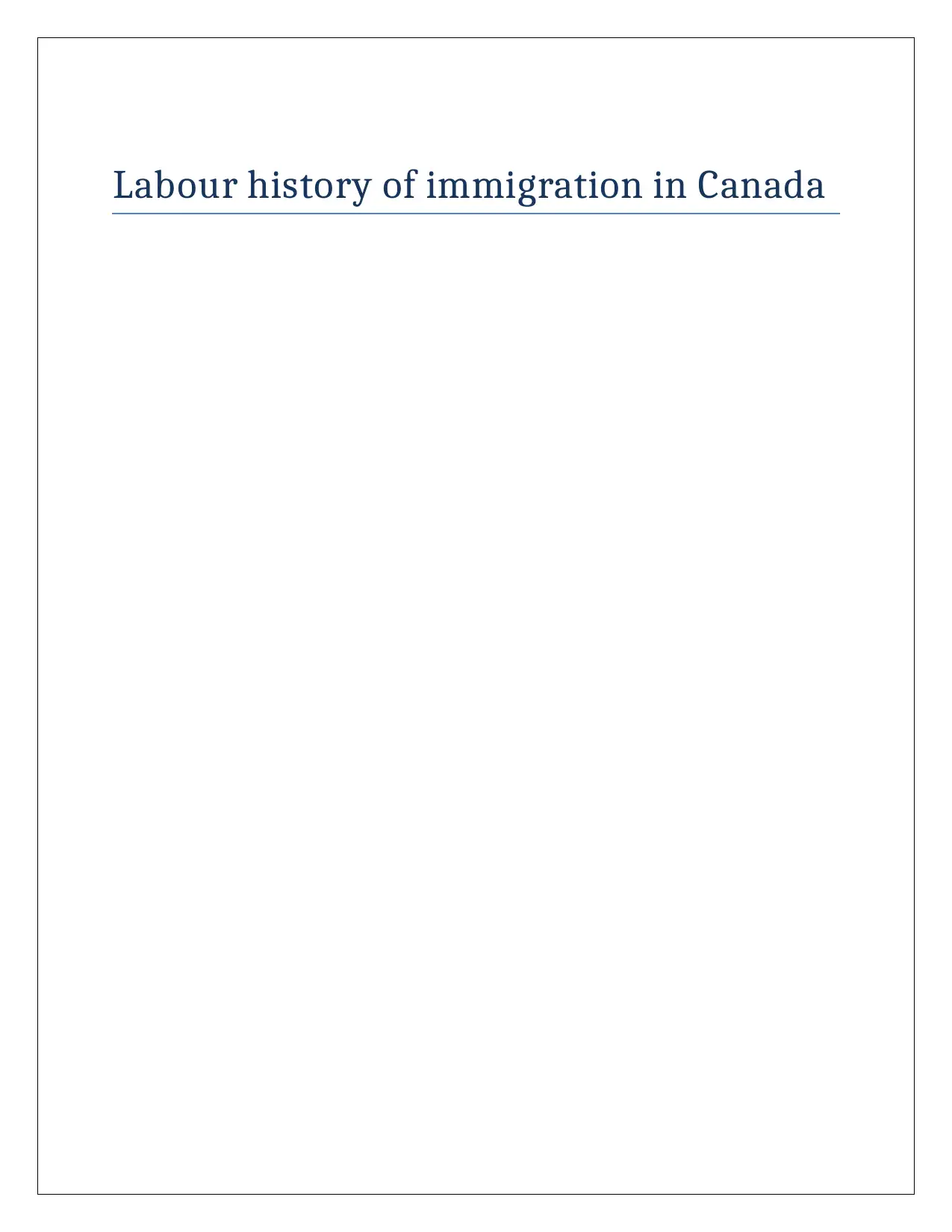
Labour history of immigration in Canada
Paraphrase This Document
Need a fresh take? Get an instant paraphrase of this document with our AI Paraphraser
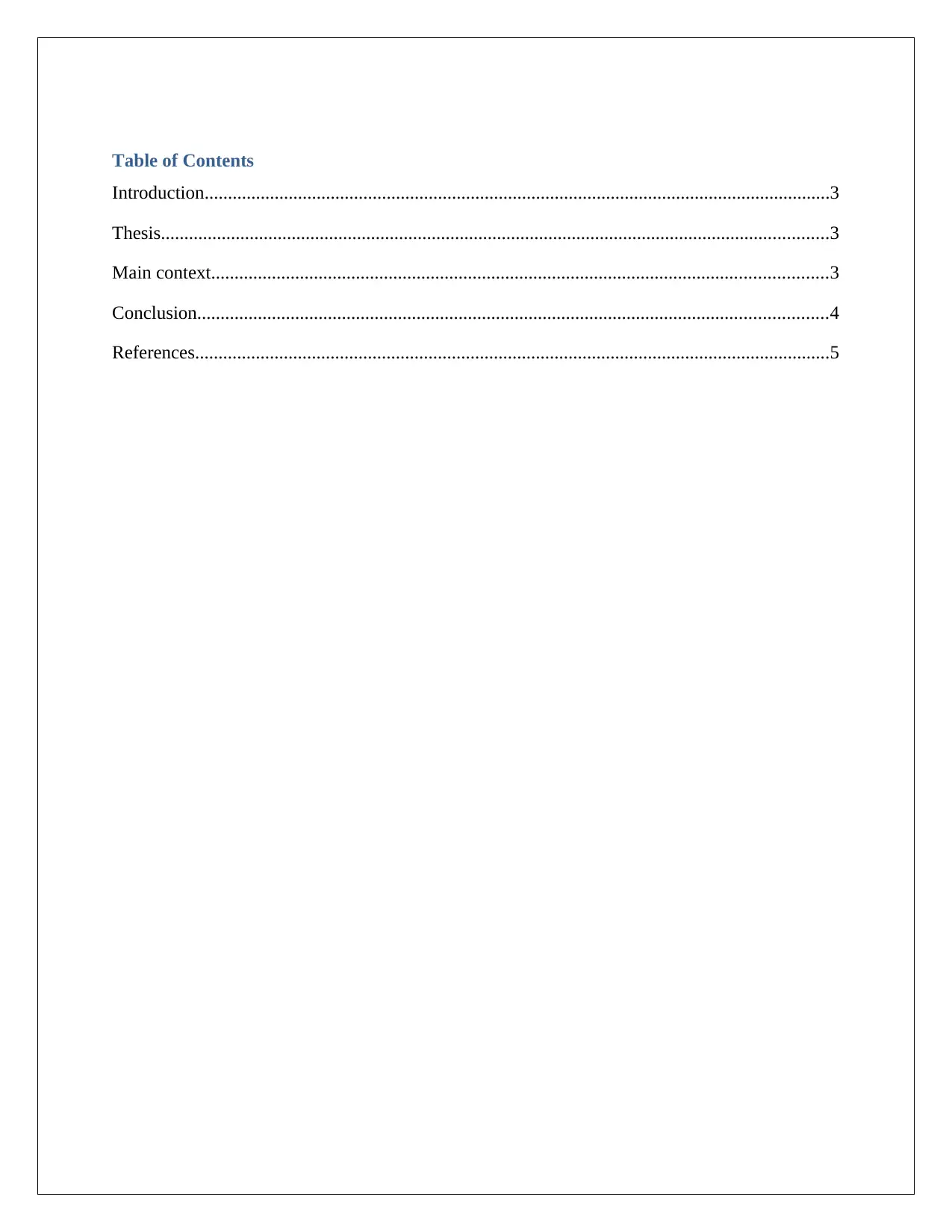
Table of Contents
Introduction......................................................................................................................................3
Thesis...............................................................................................................................................3
Main context....................................................................................................................................3
Conclusion.......................................................................................................................................4
References........................................................................................................................................5
Introduction......................................................................................................................................3
Thesis...............................................................................................................................................3
Main context....................................................................................................................................3
Conclusion.......................................................................................................................................4
References........................................................................................................................................5
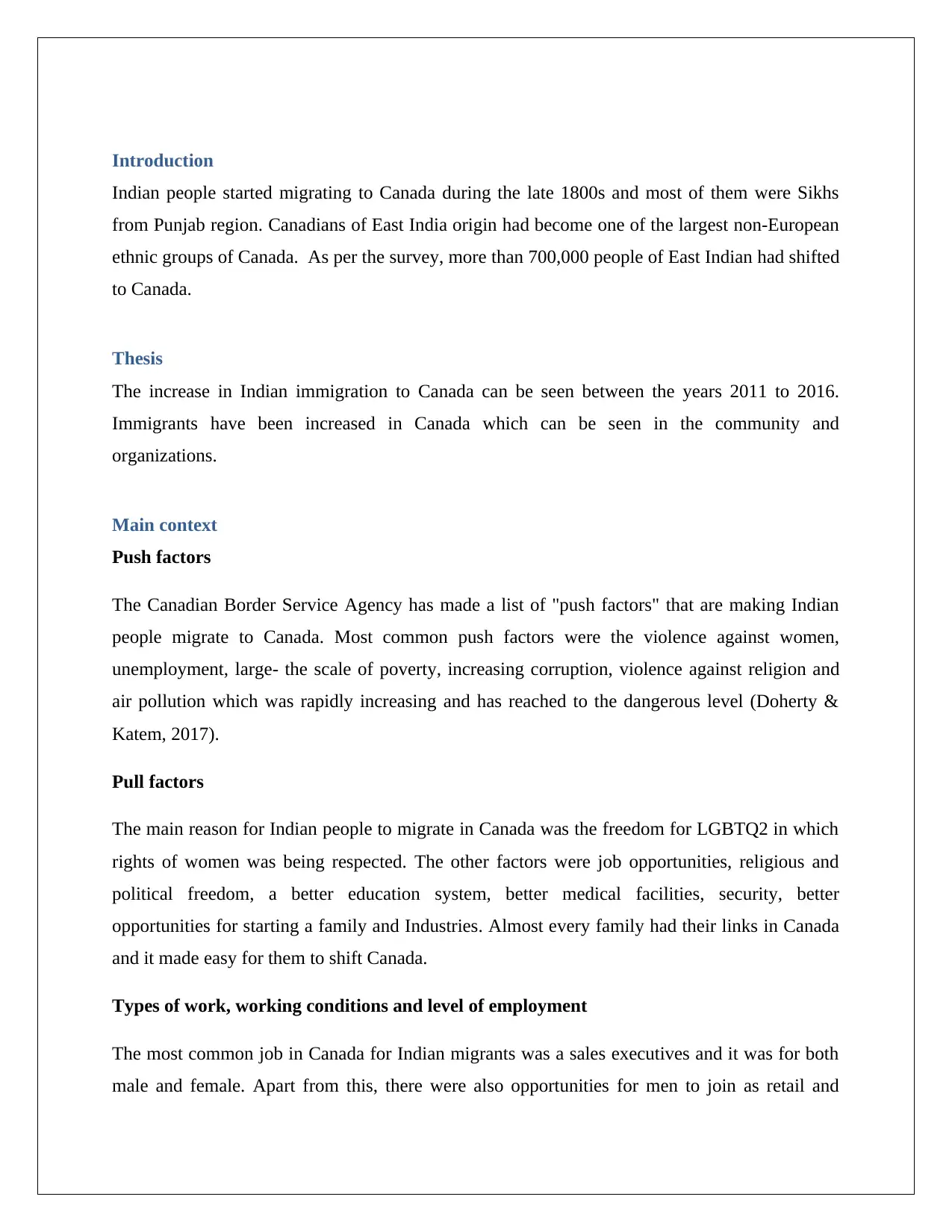
Introduction
Indian people started migrating to Canada during the late 1800s and most of them were Sikhs
from Punjab region. Canadians of East India origin had become one of the largest non-European
ethnic groups of Canada. As per the survey, more than 700,000 people of East Indian had shifted
to Canada.
Thesis
The increase in Indian immigration to Canada can be seen between the years 2011 to 2016.
Immigrants have been increased in Canada which can be seen in the community and
organizations.
Main context
Push factors
The Canadian Border Service Agency has made a list of "push factors" that are making Indian
people migrate to Canada. Most common push factors were the violence against women,
unemployment, large- the scale of poverty, increasing corruption, violence against religion and
air pollution which was rapidly increasing and has reached to the dangerous level (Doherty &
Katem, 2017).
Pull factors
The main reason for Indian people to migrate in Canada was the freedom for LGBTQ2 in which
rights of women was being respected. The other factors were job opportunities, religious and
political freedom, a better education system, better medical facilities, security, better
opportunities for starting a family and Industries. Almost every family had their links in Canada
and it made easy for them to shift Canada.
Types of work, working conditions and level of employment
The most common job in Canada for Indian migrants was a sales executives and it was for both
male and female. Apart from this, there were also opportunities for men to join as retail and
Indian people started migrating to Canada during the late 1800s and most of them were Sikhs
from Punjab region. Canadians of East India origin had become one of the largest non-European
ethnic groups of Canada. As per the survey, more than 700,000 people of East Indian had shifted
to Canada.
Thesis
The increase in Indian immigration to Canada can be seen between the years 2011 to 2016.
Immigrants have been increased in Canada which can be seen in the community and
organizations.
Main context
Push factors
The Canadian Border Service Agency has made a list of "push factors" that are making Indian
people migrate to Canada. Most common push factors were the violence against women,
unemployment, large- the scale of poverty, increasing corruption, violence against religion and
air pollution which was rapidly increasing and has reached to the dangerous level (Doherty &
Katem, 2017).
Pull factors
The main reason for Indian people to migrate in Canada was the freedom for LGBTQ2 in which
rights of women was being respected. The other factors were job opportunities, religious and
political freedom, a better education system, better medical facilities, security, better
opportunities for starting a family and Industries. Almost every family had their links in Canada
and it made easy for them to shift Canada.
Types of work, working conditions and level of employment
The most common job in Canada for Indian migrants was a sales executives and it was for both
male and female. Apart from this, there were also opportunities for men to join as retail and
⊘ This is a preview!⊘
Do you want full access?
Subscribe today to unlock all pages.

Trusted by 1+ million students worldwide
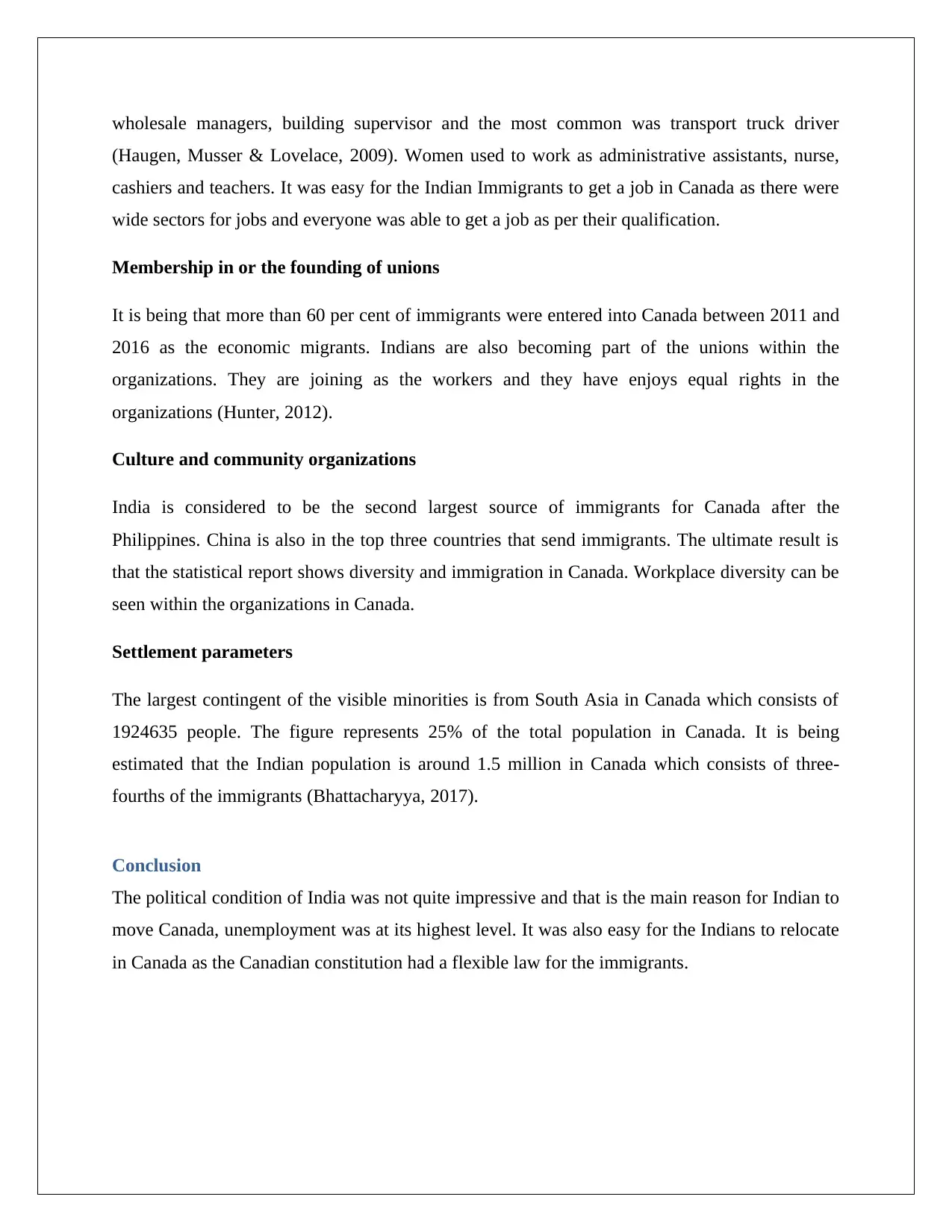
wholesale managers, building supervisor and the most common was transport truck driver
(Haugen, Musser & Lovelace, 2009). Women used to work as administrative assistants, nurse,
cashiers and teachers. It was easy for the Indian Immigrants to get a job in Canada as there were
wide sectors for jobs and everyone was able to get a job as per their qualification.
Membership in or the founding of unions
It is being that more than 60 per cent of immigrants were entered into Canada between 2011 and
2016 as the economic migrants. Indians are also becoming part of the unions within the
organizations. They are joining as the workers and they have enjoys equal rights in the
organizations (Hunter, 2012).
Culture and community organizations
India is considered to be the second largest source of immigrants for Canada after the
Philippines. China is also in the top three countries that send immigrants. The ultimate result is
that the statistical report shows diversity and immigration in Canada. Workplace diversity can be
seen within the organizations in Canada.
Settlement parameters
The largest contingent of the visible minorities is from South Asia in Canada which consists of
1924635 people. The figure represents 25% of the total population in Canada. It is being
estimated that the Indian population is around 1.5 million in Canada which consists of three-
fourths of the immigrants (Bhattacharyya, 2017).
Conclusion
The political condition of India was not quite impressive and that is the main reason for Indian to
move Canada, unemployment was at its highest level. It was also easy for the Indians to relocate
in Canada as the Canadian constitution had a flexible law for the immigrants.
(Haugen, Musser & Lovelace, 2009). Women used to work as administrative assistants, nurse,
cashiers and teachers. It was easy for the Indian Immigrants to get a job in Canada as there were
wide sectors for jobs and everyone was able to get a job as per their qualification.
Membership in or the founding of unions
It is being that more than 60 per cent of immigrants were entered into Canada between 2011 and
2016 as the economic migrants. Indians are also becoming part of the unions within the
organizations. They are joining as the workers and they have enjoys equal rights in the
organizations (Hunter, 2012).
Culture and community organizations
India is considered to be the second largest source of immigrants for Canada after the
Philippines. China is also in the top three countries that send immigrants. The ultimate result is
that the statistical report shows diversity and immigration in Canada. Workplace diversity can be
seen within the organizations in Canada.
Settlement parameters
The largest contingent of the visible minorities is from South Asia in Canada which consists of
1924635 people. The figure represents 25% of the total population in Canada. It is being
estimated that the Indian population is around 1.5 million in Canada which consists of three-
fourths of the immigrants (Bhattacharyya, 2017).
Conclusion
The political condition of India was not quite impressive and that is the main reason for Indian to
move Canada, unemployment was at its highest level. It was also easy for the Indians to relocate
in Canada as the Canadian constitution had a flexible law for the immigrants.
Paraphrase This Document
Need a fresh take? Get an instant paraphrase of this document with our AI Paraphraser
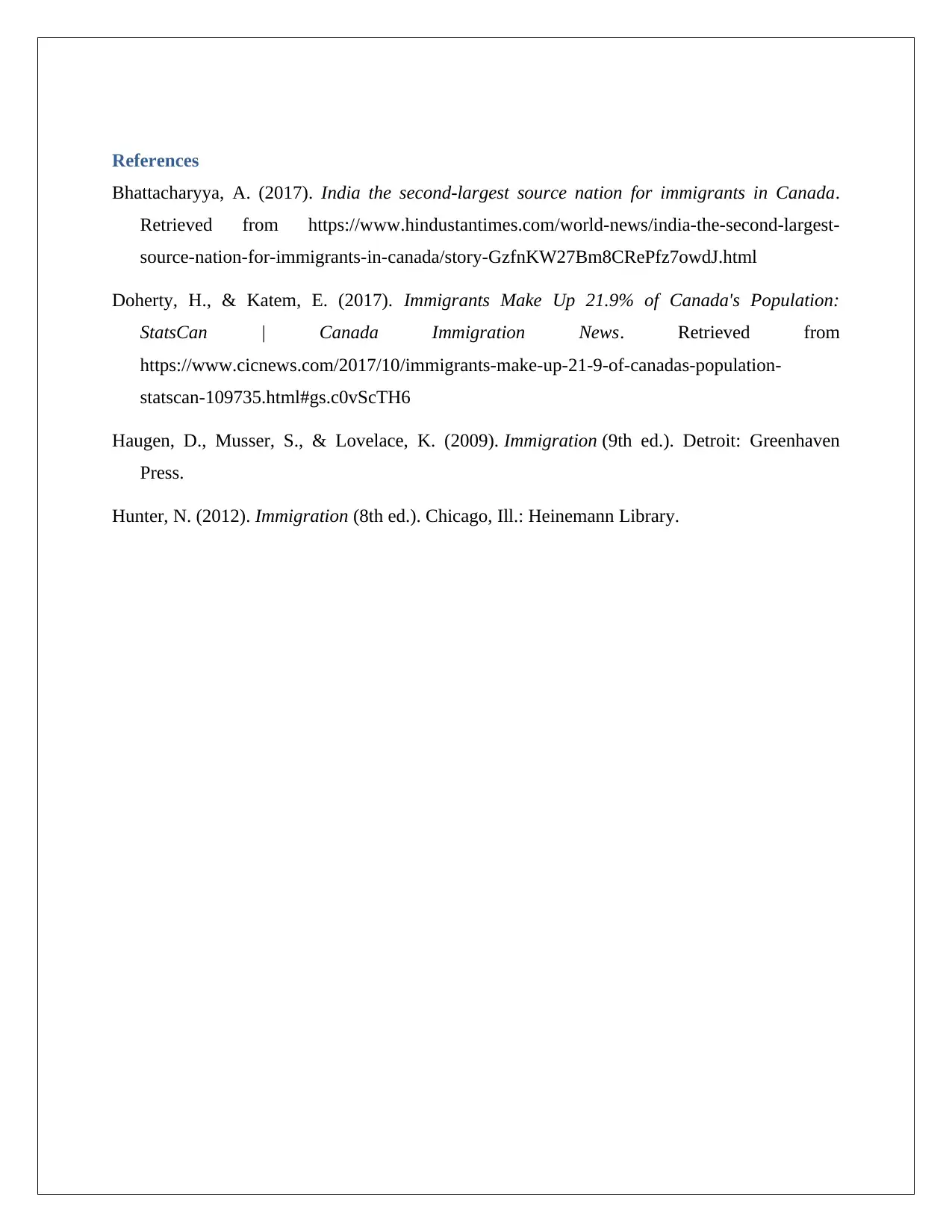
References
Bhattacharyya, A. (2017). India the second-largest source nation for immigrants in Canada.
Retrieved from https://www.hindustantimes.com/world-news/india-the-second-largest-
source-nation-for-immigrants-in-canada/story-GzfnKW27Bm8CRePfz7owdJ.html
Doherty, H., & Katem, E. (2017). Immigrants Make Up 21.9% of Canada's Population:
StatsCan | Canada Immigration News. Retrieved from
https://www.cicnews.com/2017/10/immigrants-make-up-21-9-of-canadas-population-
statscan-109735.html#gs.c0vScTH6
Haugen, D., Musser, S., & Lovelace, K. (2009). Immigration (9th ed.). Detroit: Greenhaven
Press.
Hunter, N. (2012). Immigration (8th ed.). Chicago, Ill.: Heinemann Library.
Bhattacharyya, A. (2017). India the second-largest source nation for immigrants in Canada.
Retrieved from https://www.hindustantimes.com/world-news/india-the-second-largest-
source-nation-for-immigrants-in-canada/story-GzfnKW27Bm8CRePfz7owdJ.html
Doherty, H., & Katem, E. (2017). Immigrants Make Up 21.9% of Canada's Population:
StatsCan | Canada Immigration News. Retrieved from
https://www.cicnews.com/2017/10/immigrants-make-up-21-9-of-canadas-population-
statscan-109735.html#gs.c0vScTH6
Haugen, D., Musser, S., & Lovelace, K. (2009). Immigration (9th ed.). Detroit: Greenhaven
Press.
Hunter, N. (2012). Immigration (8th ed.). Chicago, Ill.: Heinemann Library.

⊘ This is a preview!⊘
Do you want full access?
Subscribe today to unlock all pages.

Trusted by 1+ million students worldwide
1 out of 6
Related Documents
Your All-in-One AI-Powered Toolkit for Academic Success.
+13062052269
info@desklib.com
Available 24*7 on WhatsApp / Email
![[object Object]](/_next/static/media/star-bottom.7253800d.svg)
Unlock your academic potential
Copyright © 2020–2025 A2Z Services. All Rights Reserved. Developed and managed by ZUCOL.




